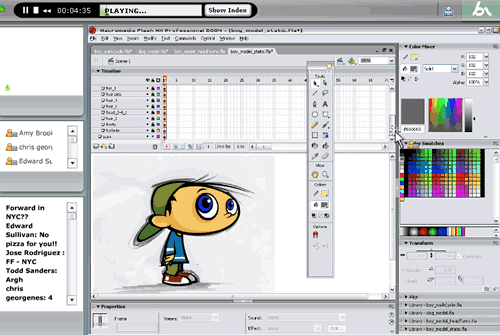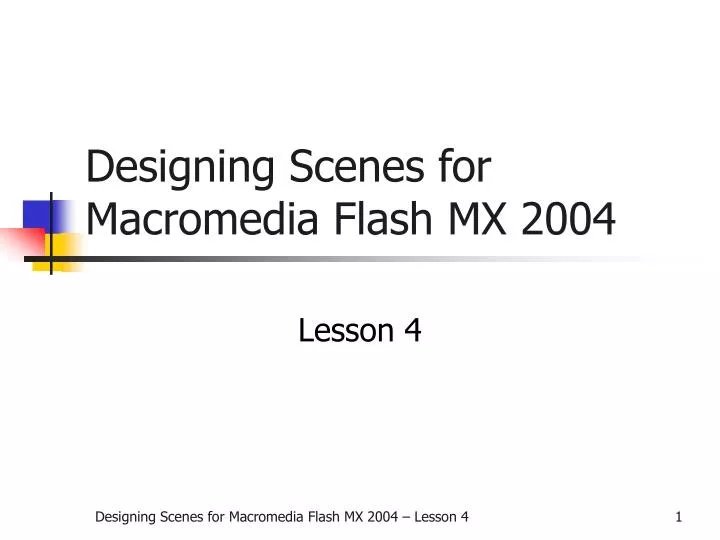Adobe Macromedia Flash Mx 2004
This feature is not available right now. Please try again later. Hi, I have a problem, with Macromedia Flash MX 2004, My teacher has our Animation class using the 30 day free trial, well I've only used it for two days and it says I have no more trial days? I'm wondering if you could help or get my 28 free trial days back? Please and thank you. To update the Media Components, download the Macromedia Extension Manager. Launch the Extension Manager and use it to install the Media Components into your Flash MX Professional installation. After installing the extension, you can find the updated components in the Flash MX Professional 2004 Components Panel under Media Components. This is a Flash 8 vs. Flash MX 2004 issue. Anyone else noticing a difference saving files over a network from Flash 8. I have never had a problem with Flash MX 2004 saving over a network, but now saving a 14 MB flash file to a Mac OS X Server is taking up to 2 minutes over AFP!! Online activation is no longer available for Macromedia branded products, including Captivate, Contribute, Flash Paper, Freehand, Director MX, Dreamweaver MX, Fireworks MX, Flash MX, and Macromedia MX. This product update resolves issues identified in Flash MX 2004 and Flash MX Professional 2004 to improve performance and stability. All users running the.
Macromedia Flash MX Professional 2004 Video Update

Welcome to the Video Update for Macromedia® Flash™ MX Professional 2004. This update contains Flash Video Exporter version 1.2, and updated Media Components (build 471).

This update includes the following:
A crunching noise in the knee can be due to a lot of things. A lot of the time, it’s due to the buildup of gas in the area that surrounds the joint. This creates tiny air pockets within the synovial fluid. When the knee is bent, these air pockets will dissipate, which can cause a “pop” or “snap” sound. Crackling noise in knee when walking. Crepitus in the knee is common and usually painless. There’s no need to be concerned about it. However, pain that accompanies the crackling and popping sounds could indicate a problem. Oct 09, 2017 The cracking sound occurs when the joints are moved apart from each other creating a gap where synovial fluid forms a bubble. This bubble when it collapses or bursts causes the cracking sound. Another cause for Knee Cracking is believed to be over stretching of ligaments that surround the synovial membrane which produce the cracking sound. Popping and cracking sounds usually aren't signs that something's wrong. “A lot of joints crack and the knees are a really common joint to crack,” says David McAllister, MD, director of the UCLA's.
Flash Video Exporter
Includes several enhancements and bug fixes, including:
- With version 1.1:
- A new “two-pass” encoder that delivers even better image quality
- Video length information is included in encoded files; this information is automatically detected by the updated Media Components
- Frames per second setting was not handled properly in some video editing software packages
- With version 1.2:
- Support for the following English software:
- Windows:
- Cleaner XL 6.0 Second Package
- QuickTime Pro 6.4
- Avid Xpress 4.0
- Adobe After Effects 6.0
- Macintosh
- Final Cut Pro 4.0 and 4.1
- Adobe After Effects 6.0
- Cleaner 6.0.1
- QuickTime Pro 6.4 and 6.5
- Windows:
- Support for the following Japanese software:
- Windows:
- Adobe After Effects 6.0 Japanese version
- QuickTime Pro 6.5 Japanese version
- Avid Xpress 4.0 Japanese version
- Macintosh
- Adobe After Effects 6.0 Japanese version
- Final Cut Pro 4.0 Japanese version
- QuickTime Pro 6.5 Japanese version
- Avid Xpress 4.0 Japanese version
- Windows:
Media Components
Adobe Macromedia Flash Mx 2004 Free
Include several enhancements and bug fixes, including:
- With version 453:
- Better interoperability for RTMP streaming with Flash Communication Server, including better seeking and better scrub bar control
- Support for the new Flash Video Streaming Service powered by VitalStream when using the Flash Video Streaming Service Behavior from VitalStream
- Supports automatic file Video Length detection (in all forms of delivery: progressive download, RTMP streaming, and from the Flash Video Streaming Service) when encoding FLV files using Flash Video Exporter version 1.1
- With version 471:
- Media Components in movieclips which are not on the stage no longer play automatically when a setMedia method is called on them, regardless of their autoPlay property setting.
- CuePoints don't fire when a play() call sends the playhead to a time before the cuePoints.
- Internet Explorer 5 for the Macintosh no longer crashes when playing movies which contain more than 3 RTMP streams played from a Media Component.
- The cuePoint event now refers to the broadcasting instance (either MediaDisplay or MediaPlayback) for event.target, instead of to the cuePoint object.
- The cuePoint event now uses event.cuePointName and event.cuePointTime when referring to the name and time of the cuePoint fired in the event.
- Improved functionality when changing between media.
- The autoSize property of MediaDisplay and MediaPlayback components now can be adjusted at runtime.
- All three components have more default bindable properties in the schema tab of the Component Inspector.
To Install
Download the Flash Video Update. Then follow these instructions to install:
- If you have installed Flash Video Exporter 1.1, on Windows you must first remove it via Start > Settings > Control Panel > Add/Remove Programs before installing version 1.2. (You do not need to remove Flash Video Exporter 1.0 installations before installing version 1.2.)
- Download and extract the Flash Video Update download file.
- To update the Flash Video Exporter, doubleclick the file 'Flash_Video_Exporter.exe' (Windows) or 'Flash_Video_Exporter.dmg' (Macintosh).
- To update the Media Components, download the Macromedia Extension Manager . Launch the Extension Manager and use it to install the Media Components into your Flash MX Professional installation. After installing the extension, you can find the updated components in the Flash MX Professional 2004 Components Panel under Media Components.
Important Notes
Adobe Flash Mx 2004
- You must have Flash MX Professional 2004 installed (version 7.0.1 recommended) in order to use the Video Update.
- The Media Component update will overwrite your existing Media Components and some of their associated class files. However, if Flash MX Professional 2004 is installed correctly, removing the updated Media Components using the Extension Manager will restore the original Media Components upon the next launch of Flash.
- You may need to delete your existing aso files if you have created movies using the original Flash MX Professional 2004 Media Component Behaviors. Deleting these files is not harmful, and the files will be re-created the next time you export a Flash movie. Delete the following files:
Windows 2000 and Windows XP: C:Documents and SettingsyourUserNameLocal SettingsApplication DataMacromediaFlash MX 2004enConfigurationClassesaso
Mac OS X: HD:Users:yourUserName:Library:Application Support:Macromedia:Flash MX 2004:en:Configuration:Classes:aso - Due to a limitation in Cleaner XL, the two-pass feature does not work properly in Cleaner XL on Windows.
- After playing some media in the media components and then pausing, loading new version 1.1 FLVs does not always update the frame or the controls properly. Pressing play resolves the situation.
- There are redraw problems with author-time live preview of the media components.
- If you attempt to scrub the playhead at runtime while an MP3 is loading, it will cause the media to reload.
- The playhead does not adjust quickly when loading MP3 media after playing another piece of media.
- When targeting Flash Player 6 for your Flash movies which contain media components, it is important to remember a couple of things:
a) Due to Flash Player 6 not being optimized for the media components, you should create a new media component instance for each media clip you wish to play. Simply changing the contentPath can cause the player to crash.
b) If you are working with screens and you wish to halt the play of a media component on a screen which is hidden, you will need to call the pause() method on it. Media play is not paused on hidden screens in the default as it is in Flash Player 7.
In general, it is a good idea to only target Flash Player 6 when your movie uses the Media Components in a relatively less complex manner. If you are creating something like a video jukebox, you should target Flash Player 7.